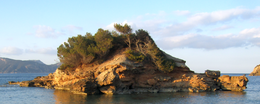S'Illot
 | |
| Geography | |
|---|---|
| Location | Mediterranean Sea |
| Coordinates | 39°52′25″N 3°09′43″E / 39.87357°N 3.16206°E |
| Archipelago | Balearic Archipelago |
| Highest elevation | 12 m (39 ft) |
| Administration | |
| Autonomous Community | Balearic Islands |
| Comarca | Raiguer |
| Municipality | Alcúdia |
| Demographics | |
| Population | 0 |
S'Illot is an uninhabited islet in the Balearic Islands, Spain, located in the Mediterranean Sea off the North coast of Mallorca.
Toponymy[edit]

S'Illot can be translated from Catalan as the little island, and must not be confused with S'illot, a touristic resort on the eastern shores of Mallorca.[1]
Features[edit]

The islet is located close to the shore north of Benaire, a town belonging to the municipality Alcúdia. Its maximum elevation on the sea level is 12 ms.[2] The beach in front of the island is known for the good views which offers on the Cap Formentor and its peninsula,[1] and the surrounding stretch of sea is appreciated for snorkelling.[3]
Geology[edit]
The island and the neighbouring coast are known by geologists for their late Pleistocene deposits and are considered a very suitable location for teaching Quaternary lithologies and stratigraphic relationships.[4]
References[edit]
- ^ a b Annie Bennett (2012-08-29). "Victòria peninsula beaches, Majorca: Secret Seaside". The Telegraph. Retrieved 2022-03-15.
- ^ "Iberpix" (in Spanish). Instituto Geográfico Nacional. Retrieved 2022-03-15.
- ^ McNaughtan, Hugh; Harper, Damian (2017). "Platja s'Illot". Lonely Planet Mallorcan. Lonely Planet Global Limited. ISBN 9781787010703. Retrieved 2022-03-15.
- ^ Boreham, S.; Boreham, J. (2019). "Late Pleistocene Coastal Geology of The s'Illot Region, Alcudia, Mallorca: A Classic Location For Quaternary Fieldwork Teaching". Quaternary Newsletter. doi:10.17863/CAM.48283. Retrieved 2022-03-15.

